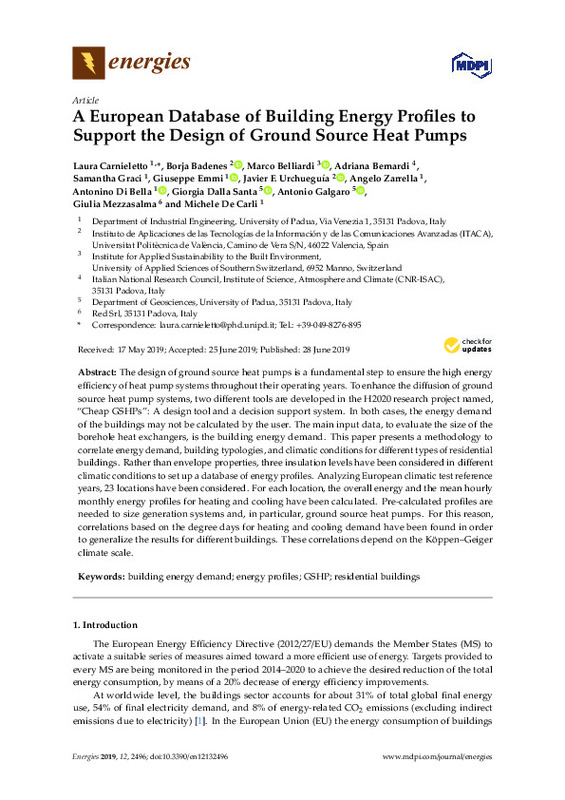De Carli, M., Tonon, M., Zarrella, A., & Zecchin, R. (2010). A computational capacity resistance model (CaRM) for vertical ground-coupled heat exchangers. Renewable Energy, 35(7), 1537-1550. doi:10.1016/j.renene.2009.11.034
Grossi, I., Dongellini, M., Piazzi, A., & Morini, G. L. (2018). Dynamic modelling and energy performance analysis of an innovative dual-source heat pump system. Applied Thermal Engineering, 142, 745-759. doi:10.1016/j.applthermaleng.2018.07.022
Engineering Reference Manual. In EnergyPlus V8.5https://energyplus.net/
[+]
De Carli, M., Tonon, M., Zarrella, A., & Zecchin, R. (2010). A computational capacity resistance model (CaRM) for vertical ground-coupled heat exchangers. Renewable Energy, 35(7), 1537-1550. doi:10.1016/j.renene.2009.11.034
Grossi, I., Dongellini, M., Piazzi, A., & Morini, G. L. (2018). Dynamic modelling and energy performance analysis of an innovative dual-source heat pump system. Applied Thermal Engineering, 142, 745-759. doi:10.1016/j.applthermaleng.2018.07.022
Engineering Reference Manual. In EnergyPlus V8.5https://energyplus.net/
Sandberg, N. H., Bergsdal, H., & Brattebø, H. (2011). Historical energy analysis of the Norwegian dwelling stock. Building Research & Information, 39(1), 1-15. doi:10.1080/09613218.2010.528186
Application of Energy Performance Indicators for Residential Building Stocks Experiences of the EPISCOPE Projecthttp://episcope.eu/fileadmin/episcope/public/docs/reports/EPISCOPE_Indicators_ConceptAndExperiences.pdf
Gustafsson, M., Dipasquale, C., Poppi, S., Bellini, A., Fedrizzi, R., Bales, C., … Holmberg, S. (2017). Economic and environmental analysis of energy renovation packages for European office buildings. Energy and Buildings, 148, 155-165. doi:10.1016/j.enbuild.2017.04.079
De Carli, M., Bernardi, A., Cultrera, M., Dalla Santa, G., Di Bella, A., Emmi, G., … Zarrella, A. (2018). A Database for Climatic Conditions around Europe for Promoting GSHP Solutions. Geosciences, 8(2), 71. doi:10.3390/geosciences8020071
Cartalis, C., Synodinou, A., Proedrou, M., Tsangrassoulis, A., & Santamouris, M. (2001). Modifications in energy demand in urban areas as a result of climate changes: an assessment for the southeast Mediterranean region. Energy Conversion and Management, 42(14), 1647-1656. doi:10.1016/s0196-8904(00)00156-4
Kottek, M., Grieser, J., Beck, C., Rudolf, B., & Rubel, F. (2006). World Map of the Köppen-Geiger climate classification updated. Meteorologische Zeitschrift, 15(3), 259-263. doi:10.1127/0941-2948/2006/0130
Herrera, M., Natarajan, S., Coley, D. A., Kershaw, T., Ramallo-González, A. P., Eames, M., … Wood, M. (2017). A review of current and future weather data for building simulation. Building Services Engineering Research and Technology, 38(5), 602-627. doi:10.1177/0143624417705937
Peel, M. C., Finlayson, B. L., & McMahon, T. A. (2007). Updated world map of the Köppen-Geiger climate classification. Hydrology and Earth System Sciences, 11(5), 1633-1644. doi:10.5194/hess-11-1633-2007
D’Amico, A., Ciulla, G., Panno, D., & Ferrari, S. (2019). Building energy demand assessment through heating degree days: The importance of a climatic dataset. Applied Energy, 242, 1285-1306. doi:10.1016/j.apenergy.2019.03.167
Al-Hadhrami, L. M. (2013). Comprehensive review of cooling and heating degree days characteristics over Kingdom of Saudi Arabia. Renewable and Sustainable Energy Reviews, 27, 305-314. doi:10.1016/j.rser.2013.04.034
Degree Days.net-Custom Degree Day Datahttp://www.degreedays.net
Annunziata, E., Frey, M., & Rizzi, F. (2013). Towards nearly zero-energy buildings: The state-of-art of national regulations in Europe. Energy, 57, 125-133. doi:10.1016/j.energy.2012.11.049
Principle for Nearly Zero-Energy Buildings, Ecofys Germany GmbHhttp://bpie.eu/documents/BPIE/publications/LR_nZEB%20study.pdf
Ahern, C., Griffiths, P., & O’Flaherty, M. (2013). State of the Irish housing stock—Modelling the heat losses of Ireland’s existing detached rural housing stock & estimating the benefit of thermal retrofit measures on this stock. Energy Policy, 55, 139-151. doi:10.1016/j.enpol.2012.11.039
Kaklauskas, A., Zavadskas, E. K., Raslanas, S., Ginevicius, R., Komka, A., & Malinauskas, P. (2006). Selection of low-e windows in retrofit of public buildings by applying multiple criteria method COPRAS: A Lithuanian case. Energy and Buildings, 38(5), 454-462. doi:10.1016/j.enbuild.2005.08.005
Zavadskas, E., Raslanas, S., & Kaklauskas, A. (2008). The selection of effective retrofit scenarios for panel houses in urban neighborhoods based on expected energy savings and increase in market value: The Vilnius case. Energy and Buildings, 40(4), 573-587. doi:10.1016/j.enbuild.2007.04.015
Aerts, D., Minnen, J., Glorieux, I., Wouters, I., & Descamps, F. (2014). A method for the identification and modelling of realistic domestic occupancy sequences for building energy demand simulations and peer comparison. Building and Environment, 75, 67-78. doi:10.1016/j.buildenv.2014.01.021
Yang, Z., & Becerik-Gerber, B. (2014). The coupled effects of personalized occupancy profile based HVAC schedules and room reassignment on building energy use. Energy and Buildings, 78, 113-122. doi:10.1016/j.enbuild.2014.04.002
Richardson, I., Thomson, M., & Infield, D. (2008). A high-resolution domestic building occupancy model for energy demand simulations. Energy and Buildings, 40(8), 1560-1566. doi:10.1016/j.enbuild.2008.02.006
Villi, G., Peretti, C., Graci, S., & De Carli, M. (2013). Building leakage analysis and infiltration modelling for an Italian multi-family building. Journal of Building Performance Simulation, 6(2), 98-118. doi:10.1080/19401493.2012.699981
[-]









